Many bugs can cause damage to your plants while hiding in plain sight, with brown soft scale insects being one of them. It spends most of its life inactive, and even if you notice it, a scale bug on houseplants looks more like a weird growth than a bug. The difficulty in identifying these bugs is one of the reasons why brown scale bugs are so challenging to control. In fact, infestations of these nasty creatures are so common that you should anticipate an infestation at least one time a year on both indoor and outdoor plants. Read on and find out how to prevent brown scale on plants.
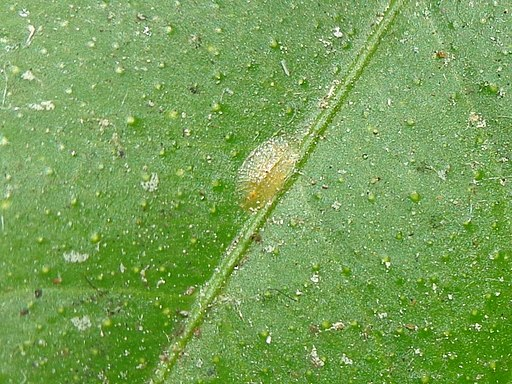
Brown soft scale is the most prevalent scale insect seen on indoor plants.
Brown scale bugs are one of the most repulsive pests you will ever encounter. They are similar in appearance to brown, flat slugs that have embedded themselves within the foliage of a tree. And believe us when we say it’s not a nice sight in any way!
Brown scale is a sap-sucking bug, and thanks to the dead scales that it leaves behind and which remain attached to the bark, its effects can be seen on woody plants throughout the year. Brown soft scales can be managed with insecticidal soaps or horticultural oils, but both methods require numerous applications to get the desired results. On the other hand, a systemic pesticide (imidacloprid) sprayed to the soil effectively controls soft brown scale on ornamental plants in one application.
If you want to discover more, keep reading. We offer information that will address all of your questions regarding brown soft scales.
What Are Brown Soft Scale Bugs?
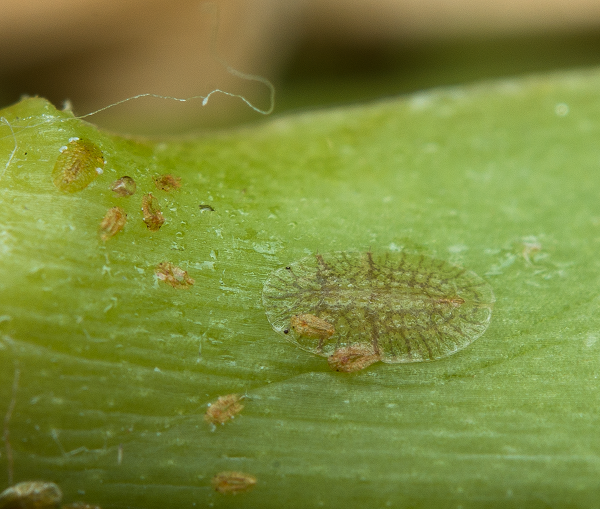
Brown scales, like many other pests of indoor plants, feed on the sap of the plants they infest.
The brown soft scale bug, a member of the Coccidae family, has a wide range of host plants. As an agricultural pest, citrus trees and commercial greenhouse crops are its principal targets. Brown soft scales can be found on both the stems and the leaves of infested plants. They spend most of their life cycle inactive, making it easier to evade detection when their numbers are low.
Their color ranges from yellow-green to yellow-brown, and the scales may have brown patches or mottling. Scales that are more than a few years old typically darken in color. Scale bugs are around 4-5mm long when fully developed and have an oval body shape, though this might vary depending on the plant part where they develop.
The male brown soft-scale bugs are significantly smaller in size compared to the females. They are equipped with wings and a massive antenna. There are very few male brown soft-scale insects, and most of the brown soft-scale bugs you will see on plants will be females. In contrast, mature female brown scale bugs are oval, light beige, golden, or yellow-brown with deeper mottling (sometimes fully dark brown) and can be up to 4.75 mm in length on average.
There are many soft-scale species capable of attacking indoor plants. The most common are the Magnolia scale, Fern scale, Cottony camellia scale, Lecanium scale/Fruit lecanium scale, Calico scale, and Wax scale/Indian wax scale.
Brown Scale Bug | Reproduction & Lifecycle
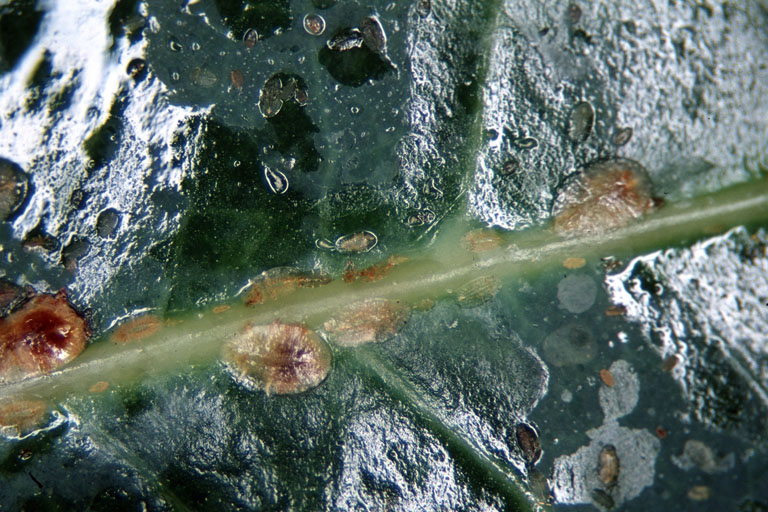
Female brown scales reproduce asexually, meaning there is no male needed.
Because of the changing climate, brown scale insects have become an even more significant nuisance. Scales become increasingly strained as temperatures rise. Additionally, the more anxious they become, the greater the number of eggs they lay.
So, if you live in a warm region, even a small number of the scales on your plant may become active and multiply into a large population.
During her lifetime, a single female brown soft scale will lay approximately 250 eggs, which are also referred to as ovisacs. Several generations can be produced in a single year. This is uncommon when compared to some other soft scale bug species, which only produce a single generation in a single year.
The mother scale will lay eggs that will hatch inside her body once they have reached their full maturity, tiny crawlers that are very little (0.4 mm) come out. These crawlers make up the first stage of the brown soft scale bug life cycle. Most of these newly hatched crawling babies will grow up to be females.
Crawlers reside for a few days within the protective covering provided by the mother scale before venturing out to colonize other parts of the plant. The crawler stage is the most mobile stage of a soft brown scale bug life cycle, and it is usually when it infects new plants or new plant areas. Although brown soft scales are more likely to be seen on plant stems, they can also sometimes be seen on the leaves of plants that they infest.
After the crawlers have begun to move, the scales will molt into a second stage, which is still minuscule compared to a fully developed adult, only measuring roughly 1.0 mm in length. This usually happens within a week or two of birth.
During the entirety of this period, there will be no change to the scales. However, once the second stage of its life cycle ends, which can last anywhere from 6 to 8 weeks, there is a possibility that the final molt to the adult form will take place, and the life cycle will complete.
The adult form of brown soft scale bug expands significantly as it produces and matures eggs, eventually reaching twice its original size in just a few short weeks. Once a female begins to reproduce, she will do so continually until she has exhausted her ability to do so, at which point she will die. This process can take anywhere from three to four weeks or longer.
Numerous generations of offspring will be produced each year on indoor house plants. As a result of the scales’ extended duration of egg-laying and the overlap in successive generations, there will be no clear annual peaks in egg production or the number of new crawlers they produce.
How Brown Scale Bugs Damage Plants?
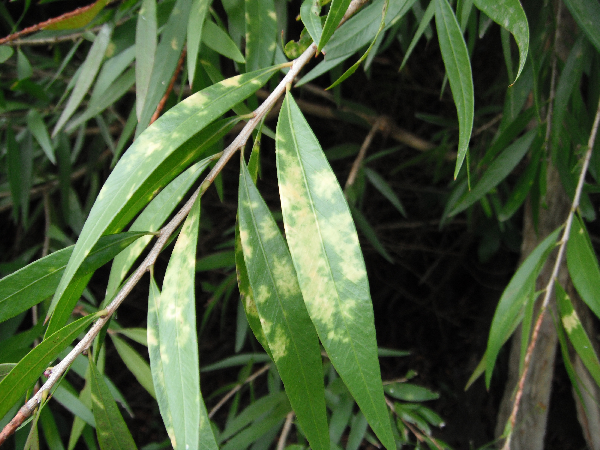
Brown scale bugs cause stunted or deformed leaf growth, brown pock marks, and possibly leaf drop.
When grown outside, plants must obtain their nutrients and minerals from the underlying soil. However, for indoor plants, it is your attention that gives them the nutrients and water they require to survive. These nutrients and minerals are transported via the components of the sieve tube elements of the phloem in the form of plant sap.
Brown scales consume this sap of a plant. They expel a sweet, gooey substance known as honeydew after eating on plant sap using piercing-sucking mouthparts. It is common for an unsightly black fungus known as a sooty mold to grow on the honeydew, which makes the leaves appear dirty and inhibits photosynthesis.
Infestations of large scales can impair plant vitality and hinder its growth. Compared to other sap-sucking insects, brown soft scales typically consume a greater quantity of sap to satisfy both their nutritional and hydration requirements. These nutrients give brown scales all they require for growth and maintaining their existence.
The damage caused by scale insects could look like pockmarks on plants such as cacti and succulents, or it might be more subtle and appear as brown or yellow leaves on a plant. The good news is that the damage caused by scale insects is not as severe or as quickly noticeable as the damage caused by spider mites; yet, it can still be quite unsightly.
Even though it would take a very long time and a massive population of scales for them to kill a large houseplant, the plant will eventually die if the infestation is not treated and taken care of.
How To Prevent Brown Scale Bugs?
Any type of plant pest can be difficult to manage, and it takes significant commitment, time, and effort to do so successfully. Unfortunately, the problem of scale insects has become more widespread worldwide due to global warming and climate change.
Heat waves are becoming longer and hotter, which kills the predators that consume scales, and brown scales reproduce more quickly in warm weather, which causes their number to skyrocket in hot regions.
Nevertheless, there are still a few things that you can do to decrease your chances of getting a brown soft scale bug infestation.
Water Your Plants Properly
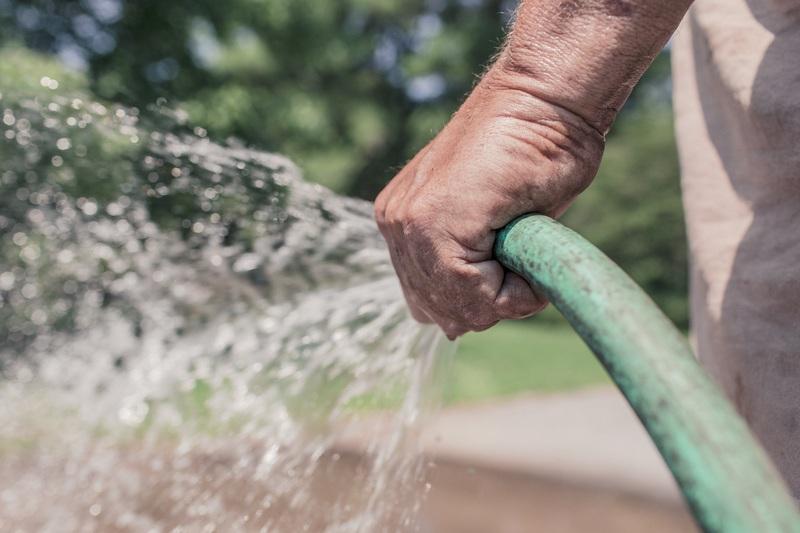
Do not overwater your plants as brown soft scale bugs love damp conditions.
Try irrigating your indoor plants more frequently in summer and hot months as it will keep the temperatures down, which will not only deter existing brown scale bugs on your plants but also deter more from coming and reproducing on your plants. This way, even if a small number of brown scales reach your plant, the temperatures that exist there will prevent them from continuously developing nymphs one after the other.
However, overwatering should be avoided since brown scale insects thrive in damp environments, and the conditions produced when plants are overwatered can encourage brown scale insects to proliferate, leading to an infestation. So, you will need to strike a balance between watering in order to bring the temperature down and to prevent conditions from being too moist at the same time.
Remove Infested Branches & Plants
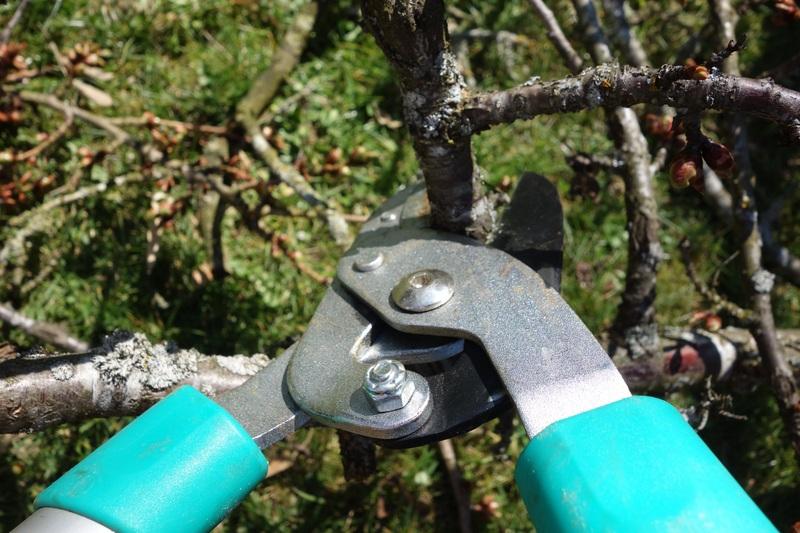
Removing and pruning scale-infested branches can help you control a scale infestation.
When their primary food source is scarce or when there are just too many piercing sap-sucking mouths to feed, soft bugs can swiftly spread to other plants. This can happen for a number of reasons. If you buy a new plant that is already infested with brown scales or if you already have a plant in your home that is infested with brown scales, there is a chance that you will spread the infestation to all of the other plants that you have in your collection.
In order to prevent this from occurring, inspect new plants thoroughly before purchasing them, and check to see that these plants are scale-free. However, if you have brought a scale-infested plant to your home, simply prune off any infected branches and leaves, and if the whole plant is infested, simply discard it from your garden.
Get Rid Of Ants
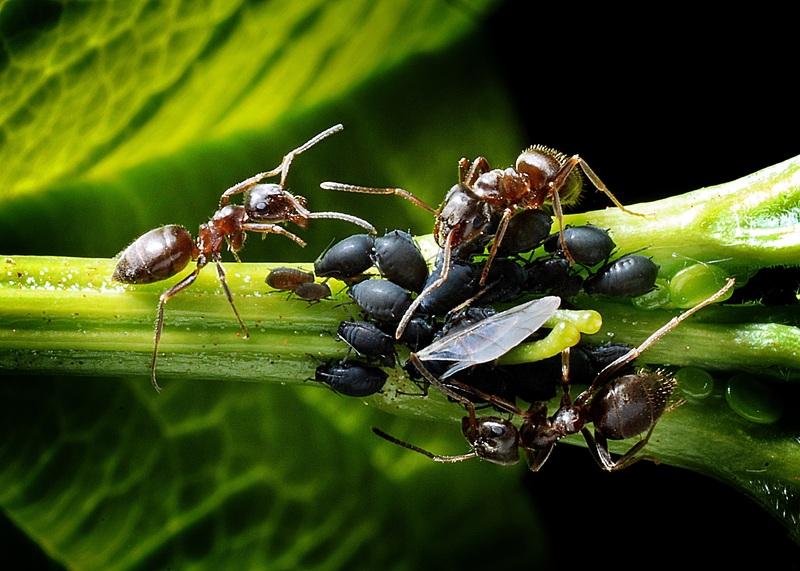
Honeydew that brown scales excrete doesn’t only create mold but also attracts ants to the plants.
Another strategy for dealing with brown soft scale pests on plants is removing ants from the trees. This can be done in one of two ways: either by preventing the ants from climbing the trunks of the trees or by destroying their nests.
Even though this may result in a brief rise in the production of sooty mold on the honeydew that the ants no longer collect, it enables natural predators to flourish and keep the scale insects under control. If you are worried about the fungus problem, fungicides are one method that can be utilized to stop the black mold from establishing a foothold.
How To Control Brown Scale Bugs On Plants?
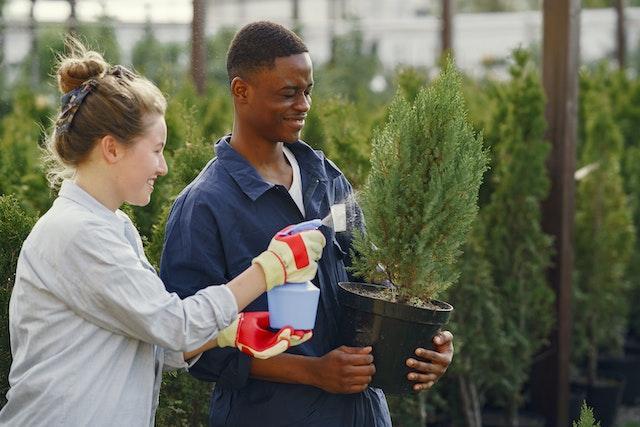
Brown soft scale bugs can sometimes infest your plants despite your best efforts and care. If you find that your plants are infested by brown scale bugs, you may take a few different approaches to get rid of them. Some of the most effective ones are given below.
How To Get Rid Of Brown Scales Naturally?
If you catch an infestation of brown scale early on, you won’t have nearly as much trouble getting rid of it. Your first line of defense against a little infestation is to go through each bug and remove it by hand. They can also be pulled off the leaves by scrubbing them. You need to have a solid stomach to complete the task in this manner.
Even among insects, brown scales have the appearance of being bothersome creatures. Here’s how to do it with neem oil and alcohol.
Get Rid Of Scale Bugs Using Alcohol

The dehydrating ability of alcohol can be used to remove scale bugs from your garden plants.
The brown scale bugs can be removed from your plants in a simple and efficient manner by using either ethanol or alcohol. However, you will need to make use of alcohol with at least 70 percent concentration. The method may not work if you use a lower concentration. However, before applying alcohol to your plants, you should test it on a small plant region as certain plants cannot tolerate concentrated alcohol solutions.
You can choose to use cotton ball or a cotton swab for this procedure. First, apply some alcohol to the cotton swab’s tip, then use it to dab any potentially contaminated areas on your plant. This should be enough to get rid of the brown scales.
After one day, check on the plant to see how it is doing. After that, you are free to continue with this method, provided it does not harm the plant tissue.
If the plant tissue causes an unfavorable reaction, you should dilute the solution and reapply it to a more contained region. Alternatively, if it does not work, you could try making your alcohol solution more concentrated.
Related: Scale Insects: How to Identify and Manage Them for Plant Health?
Get Rid Of Scale Bugs Using Neem Oil
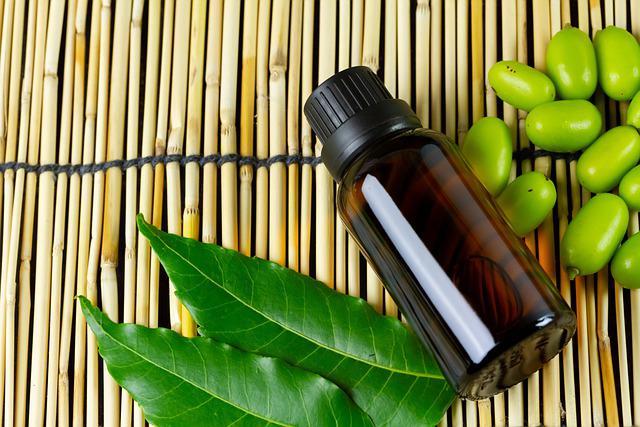
Neem oil is a natural insecticide and is very effective for treating scale on houseplants.
Natural neem oil can be used to effectively eradicate small brown scale infestations. Neem oil is extracted from the seeds of the neem plant leaves. These trees can be found in India, Pakistan, Sri Lanka and Bangladesh, among other places. Businesses will sometimes sell neem oil under the brand name “leaf shine.”
To get rid of scale bugs, combine neem oil and water in a spray bottle. Spray your plant with the resulting solution after thoroughly mixing the necessary amount of neem oil and water. It is not a good idea to make adjustments to the concentration on your own because you run the risk of causing damage to the plants.
Make sure that the entire plant you are attempting to treat is sprayed. As the plant is sprayed with neem oil, it comes into contact with the brown scales that are feeding on the plant. Because of its oily nature, it is dense, and as a result, it suffocates the scales by clogging their pores.
The presence of brown scales with hollows is a sign of death. After they have served their purpose, soft scales can be easily removed by sweeping or scraping them off.
Chemical Control Methods For Brown Scales
It’s possible that you didn’t notice brown scales when they first appeared, and now you’re getting ready to cope with a severe infestation of brown scales on your plant. Unfortunately, as mentioned previously, if the quantity of brown scales continues to rise, you will need to resort to more robust methods to eliminate them. But don’t worry, we’ll show you which methods are efficient in combating a heavy brown soft scale bug infestation.
Insecticidal Soaps
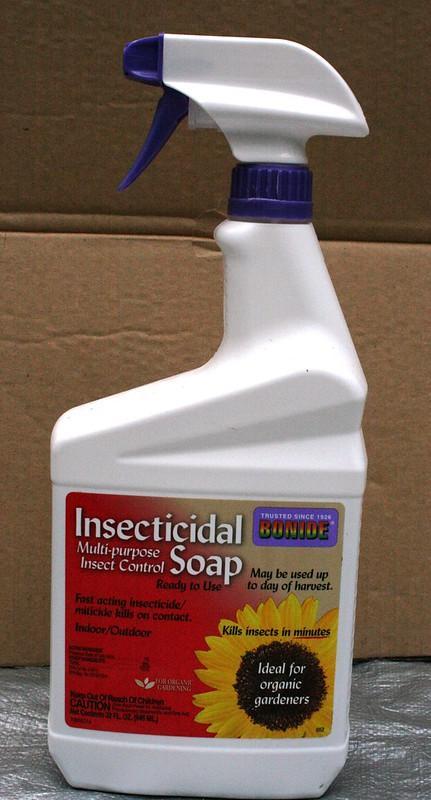
Insecticidal soaps are specially developed to kill insect pests with minimal side effects.
One of the best and most effective pesticides that may be used on brown scale bug-infested plants is insecticidal soap. Because it does not include any hazardous elements, it does not cause any harm to plants.
Fatty acids are the primary component of soap that kills insects. Brown scales are killed when the fatty acids in insecticidal soap rupture the cell membranes of their bodies. It does this by scraping off the waxy, water-impermeable covering on a soft scale and drying out the process’s bugs. This soap is not highly abrasive, and its use is not frowned upon in most circles.
On the other hand, there are some plants that are easily damaged by insecticidal soap. Before using insecticidal soap on the entire plant, observe its reaction to the treatment on a small portion of the plant first. Allow the plant at least one full day before beginning to look for any symptoms of an undesirable reaction.
You may get started by combining the water and liquid soap in a spray bottle after first mixing them together in a bowl. It is recommended that one tablespoon of this soap be added to each quart of water that is being used. Spray the plant thoroughly, and don’t overlook the undersides of the leaves, which is where the most brown scales are hidden.
Horticulture Oils
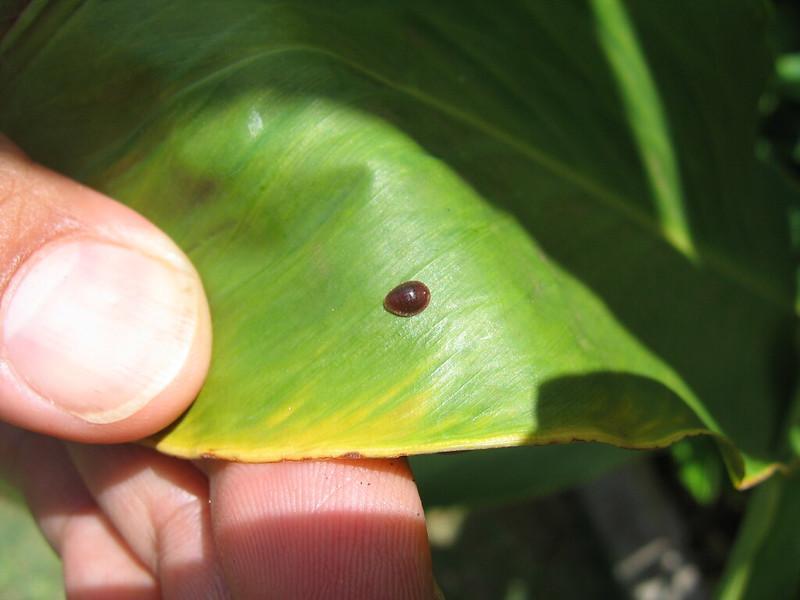
Horticultural oils are pesticides that control insects, including scale bug infestations.
Horticulture oils are another method for removing brown scales from plants. They are also known as exceptional oils and all-season oils. It is necessary for there to be physical contact between the brown scales and the oil for it to be effective in killing them. If you want the most effective results, you need to dilute these oils with water and spray them regularly. Also, the o il application is most efficient from 45F (7.2 C) to 70 F (21 C).
They eliminate the scales by blocking the breathing passages that are necessary for them to survive. Thus, they choke them to death, depriving them of oxygen, ultimately resulting in death. Moreover, horticultural oils will make it difficult for them to consume food even if they are able to maintain their ability to breathe after being sprayed. The brown scale will eventually perish due to the damage done to its metabolism.
Systemic Insecticides

The imidacloprid can effectively control soft brown scales as it migrates through plants systemically.
Systemic insecticides can be administered to the soil around some plants in order to treat pest problems. Imidacloprid’s ability to go throughout plants in a systematic manner makes it a potentially helpful tool for the management of soft brown scales.
Preparations for houseplants containing imidacloprid are either sprayed or sprinkled onto the soil before it is watered in so the roots can take in the active ingredient. There are currently two imidacloprid products that are licensed for use indoors on houseplants: Bayer Advanced 2in1 Insect Control Plus Fertilizer (2.5% imidacloprid) and Bonide Systemic Houseplant Insect Control (2.2% imidacloprid).
Both of these products can be found at your local home improvement store. However, both of these products are not appropriate for the production of food crops inside, including citrus plants grown for fruit and herb plants.
Horticultural oils and insecticidal detergents are the only options available for combating brown soft scale on food crop plants grown in greenhouses or other enclosed environments.
Insecticides For Outdoor Plants
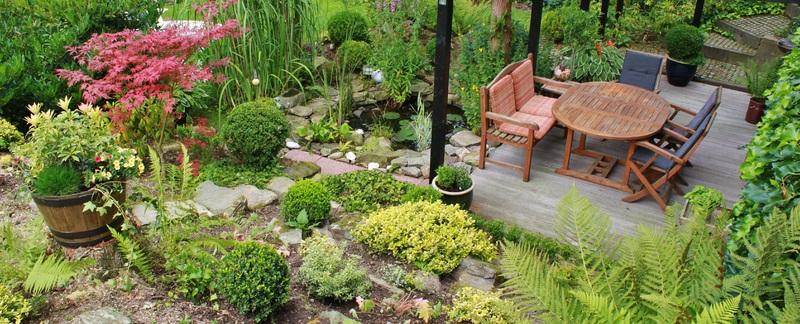
Use the insecticides mentioned below if you want to get rid of scale bugs on outdoor plants.
If plants are moved outside during the warmer months of the year and grown as ornamental plants in the open air, a few different insecticides can be used to protect them against pests, including brown scale bugs.
Most of them are sprays containing various pyrethroid insecticides, such as permethrin, lambda-cyhalothrin, cyfluthrin, and cypermethrin. Other examples include cypermethrin. Because they can remain on the plant for several days after being applied, these are the most effective way to kill the young crawler stages of the scale.
On the other hand, older scales that have developed a waxy protective layer are often immune to the effects of pyrethroid insecticide treatment. Alternately, sprays of particular systemic insecticides containing the active ingredients imidacloprid or acetamiprid can be administered to plants grown outside. These can similarly effectively control all phases of the soft brown scale.
The bulk of the directions on these product labels states that the products should only be used on ornamental plants, not those that produce edible fruit or foliage.
Conclusion
The soft brown scale bug is a really unpleasant creature. It is really necessary to get rid of them as quickly as possible in order to prevent the infestation from becoming even worse. Since dead scales do not fall off of plants, it is necessary to check the plants themselves in order to determine if the scales are living or dead.
A dead scale will be dry when it is crushed, but if the body is juicy or leaves a streak when it is smeared on a piece of paper, it is alive. Unfortunately, there is no quick solution to getting rid of scale bugs from your plants. However, if you put in some effort, you’ll be free of these parasites in no time at all.
Because there are no natural predators that can prevent the reproduction of scale insects inside of a building, the population of these insects will increase at a much faster rate. As a result, when scale infests indoor plants, you must be extremely vigilant in regulating or eliminating them from the plants.
Frequently Asked Questions
How do you get rid of scale bugs?
Infested branches, twigs, and leaves should be pruned and thrown away to get rid of scale insects. When scale numbers are low, they can be manually rubbed or plucked from plants.
For smaller infestations, however, use a soft toothbrush or cotton swab bathed in soapy water or 70% isopropyl alcohol to gently remove the scale. However, using insecticides can be required in cases of severe infestations.
What are brown soft scale insects?
The soft brown scale, also known as Coccus hesperidum, is the most important scale insect that can be found on indoor plants. Brown soft scales are born as active crawlers but spend a short time under the female’s body before emerging. In addition to feeding on stems, leaves, and green twigs, soft brown scales will occasionally consume fruits.
What does the brown scale look like?
Brown soft scales develop on houseplant stems and leaves as small, flat, oval, yellowish brown lumps. The body appears to be only slightly domed and relatively flat when viewed from the side. Scales may be speckled and range in color from yellow-green to yellow-brown. Until they are halfway grown, young scales move around; however, after they reach maturity, they cease to do so.
Where do scale bugs come from?
Scales on your indoor plants may seem to have appeared out of nowhere; however, these tiny insects may have originated from a variety of different places. Possibly you used potting soil that was tainted, exposed your plants to the elements during the months of warm weather, or recycled a dirty container for your plants.
Are scale bugs harmful to humans?
Although they may cause allergies in those who are sensitive, scale insects do not physically damage humans. In reality, the Coccoidea family of insects has been used by humans for a very long time to make colors and varnishes. However, scale insects can infest and destroy many of the plants we nurture in our landscapes and indoors.
What insecticide kills scale?
Three widely used systemic insecticides that are efficient against scale include acephate, imidacloprid, and dinotefuran. Use a systemic pesticide like Dominion 2L to effectively and reliably control scale insects on plants. The insecticides cyhalothrin, malathion, acephate, bifenthrin, cyfluthrin, and permethrin can control brown scales’ crawlers.
Does scale spread to other plants?
As newly hatched crawlers are pretty tiny, have legs, and can move around, scales spread from plant to plant. Plants with no solid basis for healthy growth are more likely to be attacked by scale insects. Crawling insects can, however, be easily managed using contact pesticides that are widely accessible.
Sources For Further Reading
Brown Soft Scale – A Common Insect Pest of Indoor Plants – 5.599. (2022). Retrieved 19 August 2022, from https://extension.colostate.edu/topic-areas/insects/brown-soft-scale-a-common-insect-pest-of-indoor-plants-5-599/#:~:text=Brown%20soft%20scale%20
How can I get rid of the soft brown scale on my bay laurel? (2018). Retrieved 19 August 2022, from https://extension.unh.edu/blog/2018/03/how-can-i-get-rid-brown-soft-scale-my-bay-laurel
Scale Insects on Indoor Plants | University of Maryland Extension. (2022). Retrieved 19 August 2022, from https://extension.umd.edu/resource/scale-insects-indoor-plants
Scale, B. (2022). Brown Soft Scale | NC State Extension Publications. Retrieved 19 August 2022, from https://content.ces.ncsu.edu/brown-soft-scale
Editor’s Recommendations
Identification and Control of Darkling Beetles by Natural and Chemical Ways
Furry Caterpillar Types with An Identification Guide, Fun Facts, and Pictures







